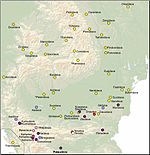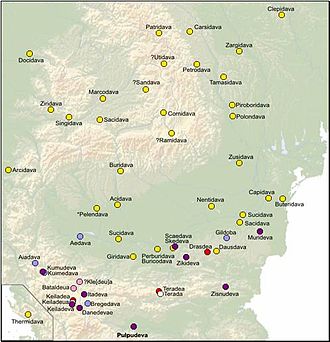- Cumidava
-
Cumidava (also Comidava, Komidava, Ancient Greek: Κομίδαυα) was originally a Dacian settlement, and later a Roman military camp on the site of the modern city of Râşnov (15 km from Braşov) in Romania.
Contents
Etymology
After Roman conquest of Dacia, the Dacian name Comidava had been modified by the Latin writers to Cumidava.[1] (Note: It is very common in the Late Latin inscriptions to express the letter "o" by "u" , e.g. patrunus instead of patronus 'protector', and Latin rumpia instead of Greek ρομφαια (Rhomphaia) 'Thracian claymore / sword'.[2])
The name Comidava is a compound of dava ‘town’ and “comi”. The scholars' opinions about the meaning of the Dacian word “Comi/Cumi” include:
- ‘Desire, love’- word explained by the ancient Iranian Kamya, with an obscure pronociation of the "a ". The term “Comi” is also contained in the name of the Dacian prince and priest Como-sicus [3]
Another town named Comidava / Cumidava was situated in the Remesiana’s territory [5]
History
Early references
Early references to Cumidava are made by the geographer Ptolemy in his Geographia, in the form Komidava (Ancient Greek: Κομίδαυα).An inscription on stone dedicated to Julia Avita Mamaea, the mother of the Roman Emperor Alexander Severus (dated 222-235 AD), allows the localization of the Dacian settlement Cumidava in the area of present-day Râşnov.[6]
The archaeological research at Râșnov was initiated in 1856 by Johann Michael Ackner[7] and continued in 1939 by Macrea Mihail who also recorded the presence of Dacian pottery during the digs at the Rasnov Roman camp[8]
The inscription found in 1939[9] [10]:
Iuliae Mameae augustae matri Domini nostri sanctissimi Imperatoris Caesaris Severi Alexandri augusti et castrorum senatusque cohors Vindelicorum Piae fidelis Cumidavensis Alexandrianae ex quaestura sua dedicante la sdio Dominatio legato augusti III Daciarum
After Roman conquest, a part of the kingdom of Dacia was included in the Roman Empire. Septimius Severus (Roman emperor from 193 to 211 AD) pushed Dacia’s eastern frontier approximately 10 to 14 kilometers (6 to 9 miles) east of the Olt River (Limes Transalutanus), constructing a series of 14 camps, over a distance of cca. 225 kilometers (140 mi), beginning at Flămânda on the Danube and stretching northward to Cumidava (now Râșnov).
Cumidava had a military road link with Angustia (now Brețcu), the farthest east of the Roman campus in Dacia.[11]
From a Dacian town to a Roman military castrum
The Roman military castrum Cumidava was identified at 4 km northwest of the city Râşnov, at the common border with the city of Vulcan. The archaeological site is located on the middle terrace of Bârsa River. It includes a defensive line of about 2 hectares.
The inscription of the Roman camp Râşnov (Braşov County) testifies about a Roman cohort of Vindelici who had taken the name Cumidava (Komidava of Ptolemy) from its place of cantonment.[12] The fact that the Romans preserved the Dacians name is quite suggestive. [13]. The native Geto-Dacian population, which became the basis for a new civilization, lent its specific characteristics, while the Latin-speaking colonists introduced Roman traits[14].
Administratively, the relatively small castrum Cumidava (110 m x 114 m) belonged to the Dacia Apulensis. It was continuously used by only two cohorts Vindelicorum Cumidavensis (cohors VI and cohors VI Nova) [15]
Sinaia lead plates
Cumidava is mentioned also on the controversial Sinaia lead plates in the form Comidava, which is used as example to debunk the myth around them. According to the director of the Romanian Institute of Archaeology, Alexandru Vulpe, the tablets include only what was known before 1900, for example, the form Comidava from Ptolemy, although now it's known that the correct spelling is Cumidava, as found in 1942 in an inscription[which?].[16]
See also
- Dacia
- Roman Dacia
- List of ancient cities in Dacia
- Dacian davae
Notes
- ^ Garbsch 1991, p. 285.
- ^ The Latin Language: An Historical Account of Latin Sounds, Stems, and Flexions by W. M. Lindsay, Cambridge University Press, 1 edition, 2010, ISBN-10: 110801240X, ISBN-13: 978-1108012409, page 34
- ^ Tomaschek, W,. “Les restes de la langue dace” in “Le Muséon, Volume 2” edited by “Société des lettres et des sciences”, Louvain, Belgium, 1883
- ^ Parvan, V., “Getica”, page 398, “Cultura Nationala”, Bucharest, Romania, 1926
- ^ Ion I. Russu , Limba Traco-Dacilor: de I. I. Russu. Ediția a 2-a revăzută si adăugită, Editura Ştiintificǎ, 1967
- ^ L'Année épigraphique: revue des publications épigraphiques relatives a l'antiquité romaine, Académie des inscriptions & belles-lettres (France) Presses Universitaires de France., 1968,
- ^ Johann Michael Ackner (1782-1862): Leben und Werk by Volker Wollmann, the University of Michigan, Dacia, 1982
- ^ The native pottery of Roman Dacia by Mircea Negru, Archaeopress, 2003
- ^ Ion I. Russu in “Inscriptiile Daciei Romane: Volume 3, Part 4”, Editura Academiei de Stiinte Sociale si Politice a RSR, Romania
- ^ Fasti archaeologici, Volumes 28-29, International Association for Classical Archaeology, Sansoni Editore., 1973 , page 461,
- ^ The Dacian Stones Speak by Paul Lachlan MacKendrick, Publisher: University of North Carolina Press, ISBN - 10:0807849391, ISBN - 13:9780807849392, 2000,
- ^ L'Année épigraphique: revue des publications épigraphiques relatives a l'antiquité romaine, Académie des inscriptions & belles-lettres (France) Presses Universitaires de France., 1968,
- ^ Morgan 2009, p. 223.
- ^ Treptow & Bolovan 1996, p. 35.
- ^ Dumitru Protase, Istoria Romanilor: Daco-Romani, Romanici, Algeni, Academia Romana, Sectia de Stiinte Istorice si Arheologie, Editura Enciclopedica, 2001,
- ^ Din tainele istoriei - Misterul tablitelor de plumb, Formula As, n. 649; 2005
References
- Treptow, Kurt W.; Bolovan, Ioan (1996). A history of Romania. East European Monographs; 3rd Revised edition edition. ISBN 978-0880333450.
- Dapper, Morgan (2009). Ol' man river : geo-archaeological aspects of rivers and river plains. Academia Press in cooperation with Ghent University, Dept. of Archaeology and Ancient History of EuropeBelgium. ISBN 978-9038214047.
- Garbsch, Jochen (1991). "The oldest military diploma for Dacia". Roman frontier studies 1989: proceedings of the XVth International Congress of Roman Frontier Studies edited by Valerie A. Maxfield, Michael J. Dobson. University of Exeter Press. pp. 281–285. ISBN 978-0859893640.
Further reading
- Olteanu, Sorin. "Linguae Thraco-Daco-Moesorum - Toponyms Section" (in Romanian, partially in English). Linguae Thraco-Daco-Moesorum. Archived from the original on 3 January 2010. http://www.webcitation.org/5vSjj8iYr. Retrieved 3 January 2010.
External links
Ancient Dacian cities and/or fortresses Acidava • Acmonia • Aedava • Aiadava • Aizis • Amutria • Apulon • Arcina • Arcobadara • Argedava • Argidava (Arcidava) • Arutela • Berzobis • Bregedava • Brucla • Buricodava • Buridava • Buteridava • Capidava • Carsidava • Clepidava • Cumidava • Danedevae • Dausdava • Desudaba • Diacum • Dierna • Dinogetia • Docidava • Drobeta • Egeta • Gatae • Genucla • Germisara • Gildava • Giridava • Itadava • Keiladeva • Klepidaua • Kuimedaba • Malva (Romula) • Marcodava • Murideva • Napoca • Nentidava • Oescus • Patridava • Patruissa • Pelendava • Perburidava • Petrodava • Pinon • Piroboridava • Polondava • Potaissa • Pulpudeva • Quemedava • Ramidava • Ratiaria • Recidava • Romboses • Rusidava • Sacidava • Sagadava • Sandava • Sangidaua • Sarmizegetusa Regia • Scaidava • Setidava • Singidava • Sucidava • Sucidava, Moesia • Susudava • Sykidaba • Tamasidava • Tapae • Thermidava • Tibiscum • Tirista • Tsierna • Tyrida • Ulpia Traiana Sarmizegetusa • Utidava • Zaldapa • Zargidava • Zeugma • Zicideva • Zimnicea • Ziridava • Zisnudeva • Zucidaua • Zurobara • Zusidava
Cities/fortresses with unknown names: Ardan • Ardeu • Arpașu de Sus • Breaza • Bretea Mureșană • Băile Tușnad • Bănița • Bâzdâna • Cernat • Cetățeni • Cotnari • Covasna • Crăsanii de Jos • Crizbav • Cuciulata • Cugir • Cârlomănești • Căpâlna • Drajna de Sus • Jigodin • Mala Kopania • Marca • Merești • Moșna • Odorheiu Secuiesc • Olteni • Orăștie Mountains • Polovragi • Porumbenii Mari • Praid • Racu • Satu Mare (Harghita) • Sprâncenata • Stâncești • Sânzieni • Șeica Mică • Tășad • Teliu • Tilișca • Timișu de Jos • Turia • Valea Seacă • Zemplín Dacia Maps on Commons • Dacian fortresses, settlements and Roman castra from Romania: Google Maps • Google Earth
Dacia Maps on Commons • Dacian fortresses, settlements and Roman castra from Romania: Google Maps • Google EarthDacia topics Dacian tribes: Aedi · Albocense · Anartes · Apuli · Artakioi · Biephi · Biessoi · Buri · Carpi · Cauci · Ciaginsi · Clariae · Costoboci · Cotini · Crobidae · Daci · Getae · Moesi · Osi · Peukini · Piephigi · Potulatense · Predasense · Rhadacense · Saldense · Scaugdae · Sense · Suci · Terizi · Teurisci · Trixae · Tyragetae · Troglodytae
Dacian kings: Culture and civilisation: Art, jewellery, treasures, tools (Bracelets) · Clothing · Foreign Relations (Greeks · Celts · Romans · Germanic tribes) · Warfare (Falx · Sica · Thracian warfare)
Sarmizegetusa · Argidava · Buridava · Cumidava · Piroboridava · Sucidava · More towns... · Davae · Dacian Fortresses of the Orăştie Mountains · Murus dacicusWars with the
Roman Empire:Roman Dacia: Dacia Traiana · Moesia · Scythia Minor · Dacia Aureliana · Diocese of Dacia · Dacia Mediterranea · Dacia Ripensis · Trajan (Bridge · Column) · Towns and cities · Castra · Limes (Alutanus · Moesiae · Porolissensis · Sarmatiae · Transalutanus · Trajan's Wall · Brazda lui Novac) · Language (Thraco-Roman · Eastern Romance substratum)Research on Dacia: Books about Dacia · Dacian archaeology · Archaeological sites in Romania · Dacology · Thracology · ProtochronismWikiProject • Commons • Dacian fortresses, settlements, Roman castra, limes from Romania: Google Maps • Google EarthCategories:- Articles to be expanded with sources
- Dacian towns
- Archaeological sites in Romania
Wikimedia Foundation. 2010.

